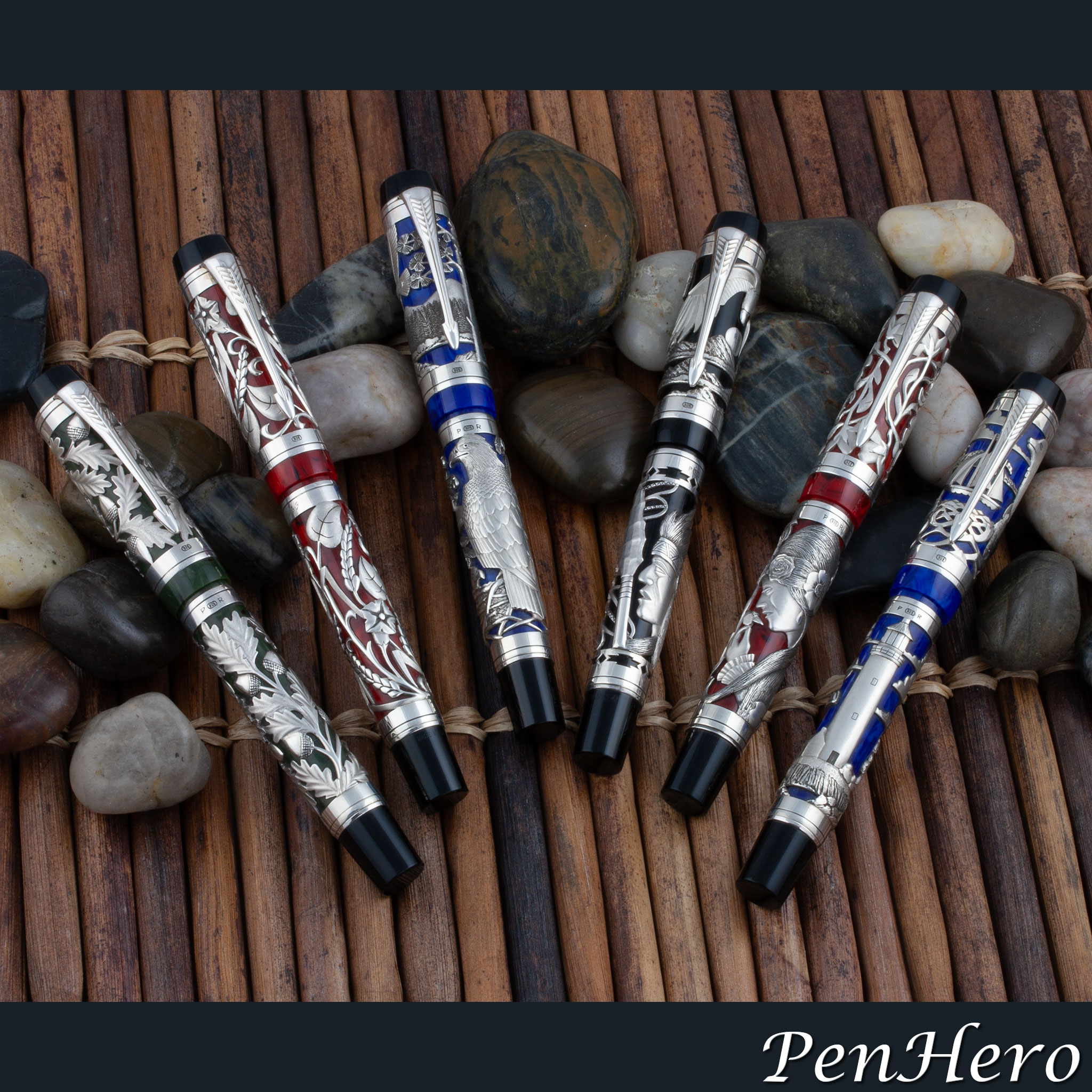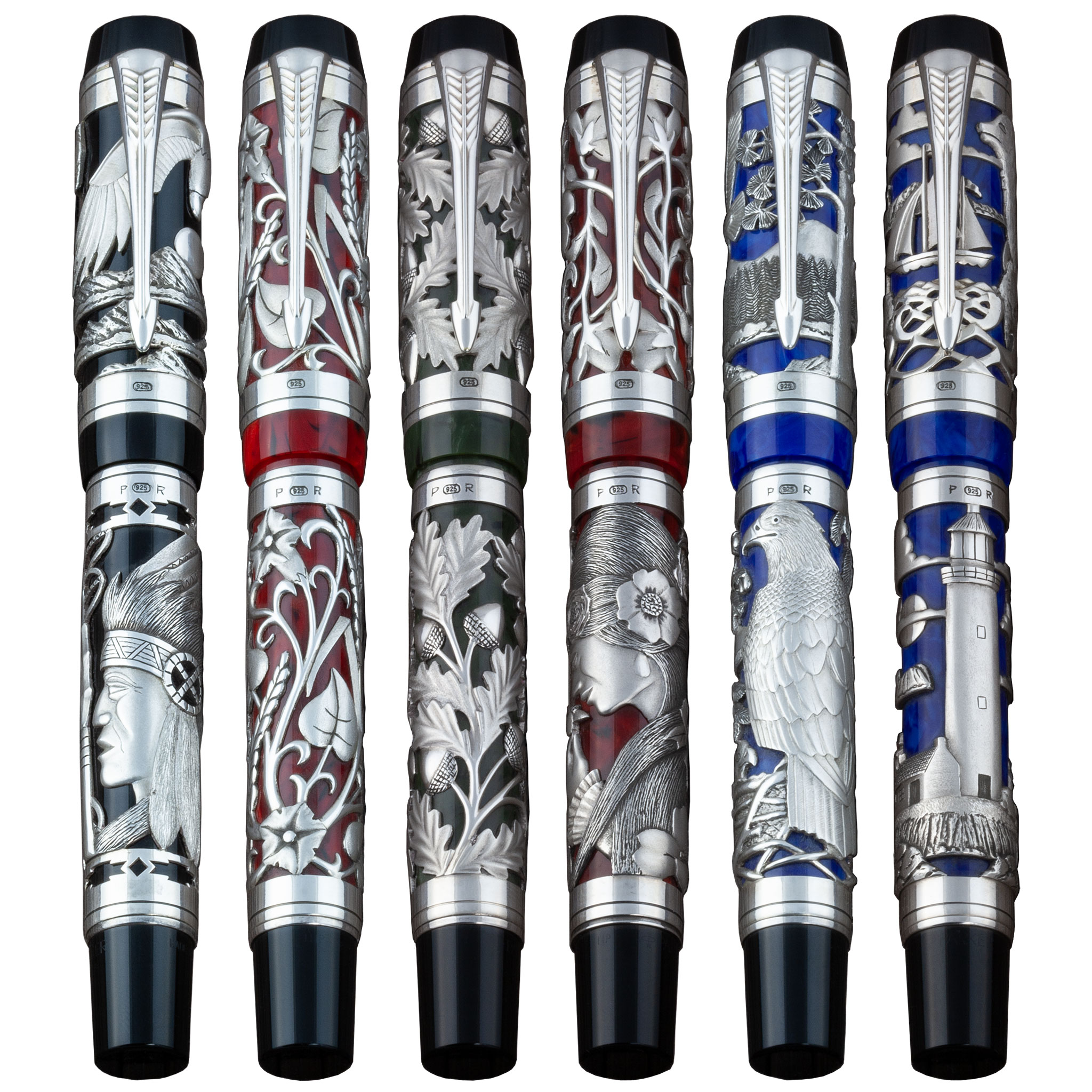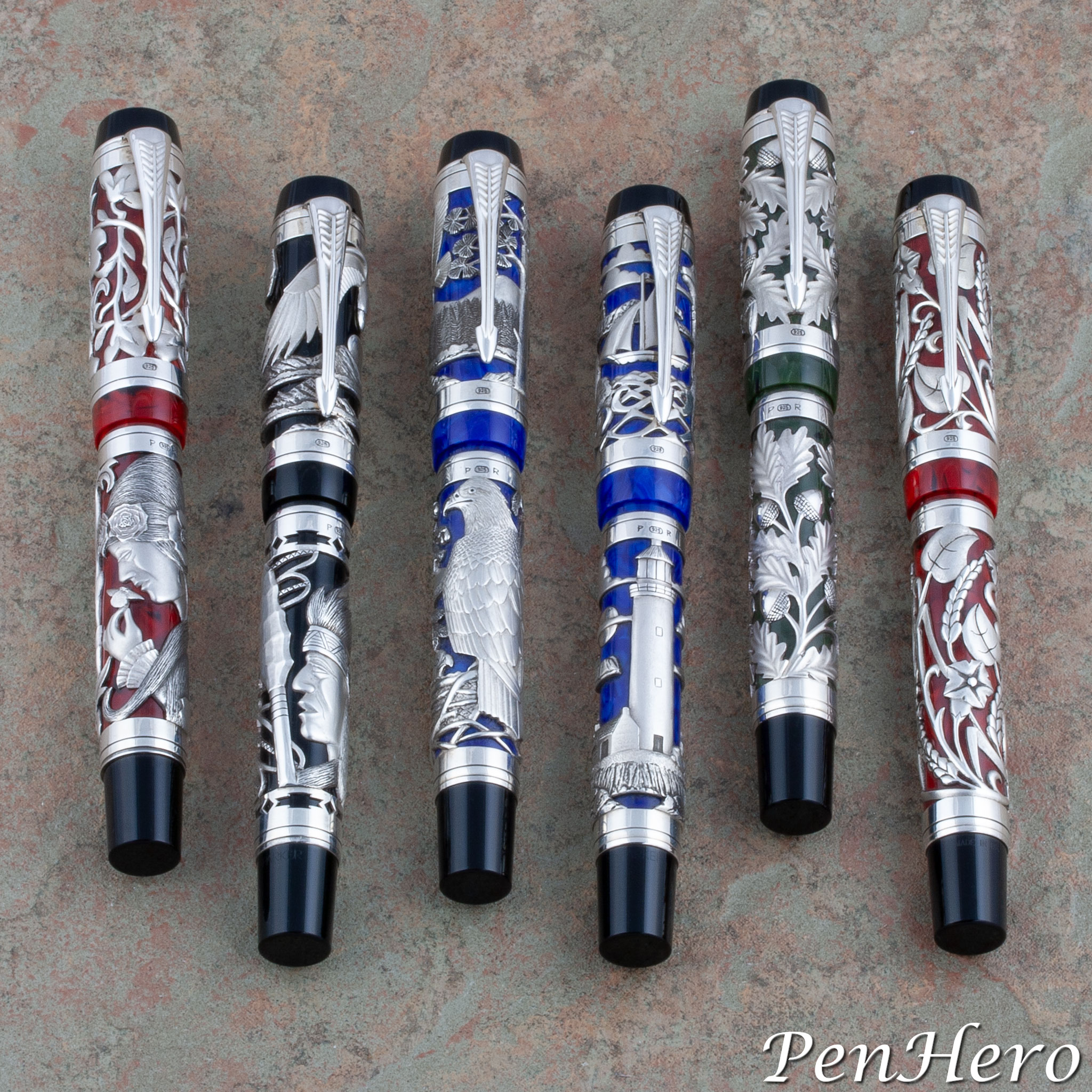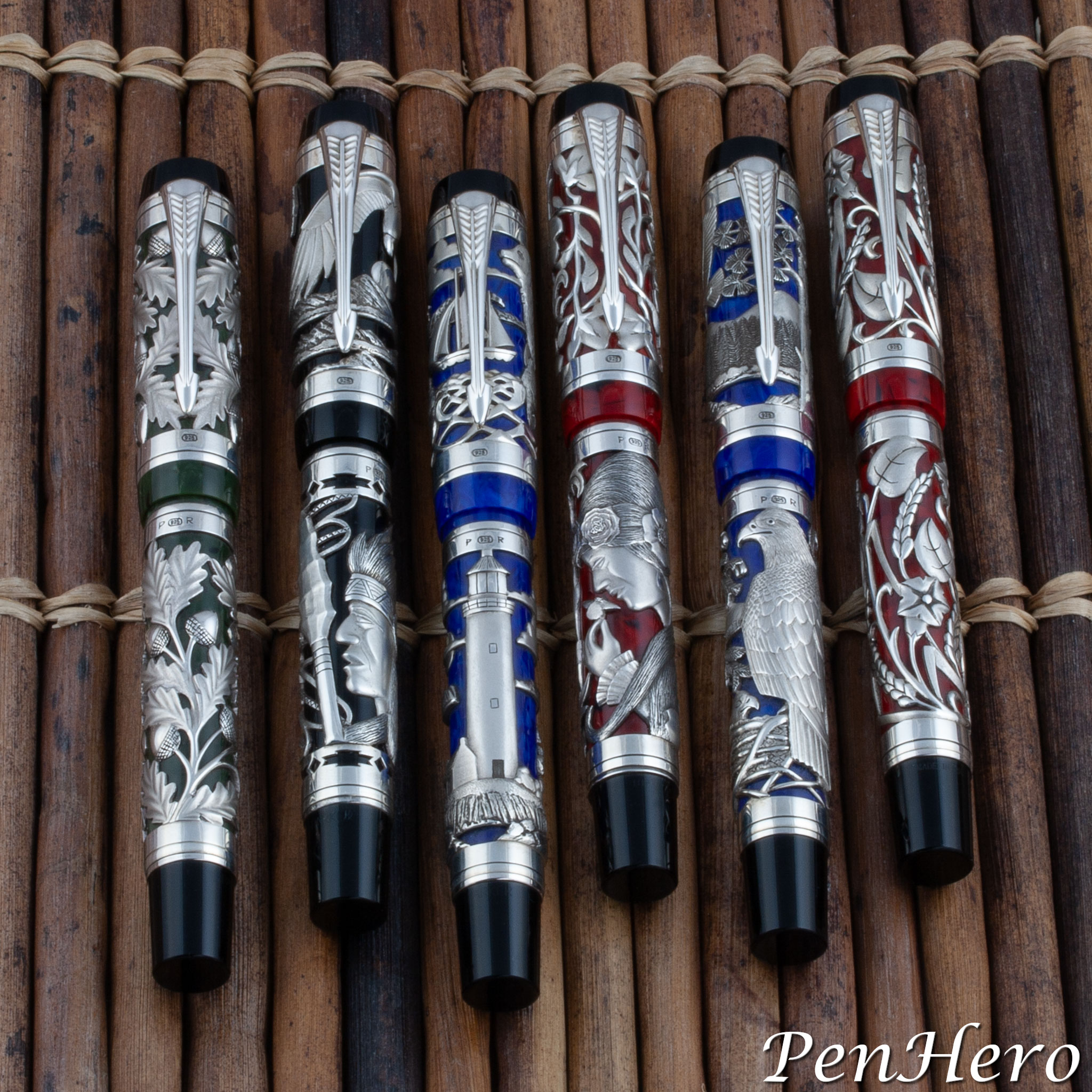Classic Pens LR Collection 2001
by Jim Mamoulides, March 8, 2024
 Classic Pens LR Collection fountain pens 2001LR3 Woodland Oak, LR2 Harvest, LR5 Alaska, LR1 Eagle Chief, LR4 Muse, and LR Lighthouse
Classic Pens LR Collection fountain pens 2001LR3 Woodland Oak, LR2 Harvest, LR5 Alaska, LR1 Eagle Chief, LR4 Muse, and LR Lighthouse
A Striking Art Pen Collection
The Classic Pens Lambrou Rossi LR collection was a collaboration between Andreas Lambrou and Paul Rossi to make a limited number of sets of five sterling silver overlay art pens. Lambrou and Rossi first met at the Los Angeles Pen Show in 1991. The relationship began with trading vintage pens with Lambrou discovering Rossi's skill for pen design and silver craft. When Lambrou moved to Los Angeles, California in 2000 he began his long time working relationship with Rossi to create art pens.
Paul Rossi was an exceptional creator of hand crafted fountain pens, with his most notable and admired work done in sterling silver. Rossi created many custom pens for collectors including overlays on existing pen models and entire pens, except for the nib and feed. Paul passed away on June 19, 2021. He was 73.
Andreas Lambrou and Keith G. Brown founded Classic Pens in England in 1987 with the goal to offer high end limited edition fountain pens. Their first edition was released in 1990, the specially engraved Classic Pens CP1, a limited run of 250 pens based on the sterling silver Sheaffer Targa. The company continued making limited edition pens for more than twenty-five years.
The LR collection was a series of sterling silver filigree overlays on Parker Duofold Centennial fountain pens. Because Rossi lived only a short distance from Classic Pen’s Los Angeles office, they had the opportunity to meet frequently in person and discuss each new pen’s design. On a trip to the UK, Lambrou showed his Parker Pen Company contacts some of Rossi’s silver filigree work and they gave permission to use the Duofold Centennial for the planned Lambrou Rossi LR Collection.
Development work on the LR pens started in 2000 and by the end of that year, Lambrou and Rossi decided on five designs. The collection, numbered LR1 to LR5, debuted at the February, 2001 Los Angeles Pen Show. It is believed that ten sets of pens with the five designs were made.
It is very rare to see all of these pens in one place and it was a special opportunity to photograph them individually and as a set.
The Five Primary Designs
 Classic Pens LR Collection fountain pens 2001LR1 Eagle Chief, LR2 Harvest, LR3 Woodland Oak, LR4 Muse, LR5 Alaska, and LR Lighthouse
Classic Pens LR Collection fountain pens 2001LR1 Eagle Chief, LR2 Harvest, LR3 Woodland Oak, LR4 Muse, LR5 Alaska, and LR Lighthouse
LR1 Eagle Chief
The first pen in the new collection was the Classic Pens LR1 Eagle Chief fountain pen, with sterling silver overlays on the cap and barrel of a black Parker Duofold Centennial. The prototype design by Rossi was based on some of his earlier silver filigree work that portrayed a Native American warrior with a single feather headdress. On the barrel is a Native American chief with full feather headdress and holding a spear. On the cap is an eagle soaring in flight with the full sun and mountains in the background. Eagles were a favorite subject for Rossi. The eagle and chief together give the design its name. The barrel has two decorative bands above and below the main design with repeating diamond and Native American style cross cutouts. It's not known if Rossi selected these from specific Native American symbols or chose them artistically.
LR2 Harvest
The second pen, the LR2 Harvest, has the design based on an original watercolor of golden wheat, grapevines, and morning glory flowers reminiscent of harvest time on the island Cyprus, as a sterling silver overlay on the Jasper Red Parker Duofold Centennial. Rossi’s design is an open, intertwining mesh of ripe seed heads of golden wheat and winding morning glory buds, leaves, and flowers leaving cutouts revealing the marbled Jasper Red acrylic of the cap and barrel as a background. Rossi evidently did not incorporate the grapevines and grapes from the original watercolor.
LR3 Woodland Oak
The cut and carved sterling silver artwork by Paul Rossi on the LR3 Woodland Oak was inspired by the American oak tree. It’s a filigree of leaves and acorns in two panels, one on the cap and one on the barrel. The leaf and acorn form favors the American white oak, a common deciduous tree in the eastern United States. Similar trees in the white oak family include the bur oak, chestnut oak, and Oregon white oak. The leaves are identified by their rounded lobes and the tips do not have bristles like the red oak. The overlays are on the Parker Duofold Centennial in Jade Green, to compliment the natural forms.
 Classic Pens LR Collection fountain pens 2001LR4 Muse, LR1 Eagle Chief, LR5 Alaska, LR Lighthouse, LR3 Woodland Oak, and LR2 Harvest
Classic Pens LR Collection fountain pens 2001LR4 Muse, LR1 Eagle Chief, LR5 Alaska, LR Lighthouse, LR3 Woodland Oak, and LR2 Harvest
LR4 Muse
Andreas Lambrou described the cut and carved sterling silver artwork by Paul Rossi on the LR4 Muse as inspired by the “Muse of sculpture,” featuring on the barrel panel the Muse’s head in profile with her long flowing flower adorned hair. The cap panel features a lattice work of flowers with their stems and leaves. Considering the roses in the Muse’s hair and the flowers throughout both panels in the LR4’s artwork, it’s very possible that Erato is the Muse for the design on this pen. The overlays are on the Parker Duofold Centennial in Jasper Red, to highlight the artwork.
LR5 Alaska
The LR5 Alaska is the fifth and final pen in the LR series. The scene cut and carved into the sterling silver cap and barrel overlay by Paul Rossi depicts a family of eagles with the cap overlay scene showing the male soaring in flight over a blue lake and against a blue sky with a mountain range in the background. The foreground shows tall trees and rocky shores lining the lake, with one tree dominating the view. The female, with two sleepy eaglets is shown at the nest, in an overlay scene on the barrel. The artwork is cut in a way to use the Lapis Lazuli Blue of the Parker Duofold Centennial pen as colorful background.
LR Lighthouse - One of a Kind
The LR Lighthouse is a one of a kind art pen following the visual design of the LR series pens. It was custom made to be a gift, and the artwork on the pen is based on a stained glass panel. The design is comprised of two views of the lighthouse as separate scenes on the cap and barrel overlay panels. The barrel panel shows a lighthouse with its attendant residence on a rocky peninsula or island. Nearby is a single large tree, and in the background is a mountainous coastline with billowing cumulous clouds overhead partially blocking the sun. The cap panel features a closeup of a seal sitting on a rock surrounded by choppy waves. A two masted schooner in full sail glides behind with the lighthouse in the background and clouds above. Each element in the design is highly detailed. Note the cliffs below the lighthouse, the seal’s fur, and the rock the seal sits on. The artwork includes cut outs that allow the Lapis Lazuli Blue of the Parker Duofold Centennial pen to become the sea and sky background.
 Classic Pens LR Collection fountain pens 2001LR3 Woodland Oak, LR1 Eagle Chief, LR Lighthouse, LR4 Muse, LR5 Alaska, and LR2 Harvest
Classic Pens LR Collection fountain pens 2001LR3 Woodland Oak, LR1 Eagle Chief, LR Lighthouse, LR4 Muse, LR5 Alaska, and LR2 Harvest
The base pen for each LR series pen is the Parker Duofold Centennial, which was introduced in 1987 as a modern interpretation of the flattop Parker Duofold of the 1920s. Parker updated the pen in 1996 with several new design changes, favoring the streamlined Duofold design introduced in 1929. The changes included a new two tone 18 karat gold nib, a tapered cap top, a new cap top emblem, a single plated band on the nib section, two wide cap bands, a single plated barrel end trim band, and a shorter barrel end cap. Interestingly, this pen has the nib from the earlier Duofold Centennial, but I don’t know the story behind why. In addition to black, three new marbled cap and barrel colors were introduced, Jasper Red, Jade Green, and Lapis Lazuli Blue, made from acrylic resin.
The cap and barrel overlays on each pen are hallmarked 925 in an oval, indicating sterling silver, on the front near where the cap and barrel meet, and below the clip on the cap. The barrel overlay has Paul Rossi’s initials on either side of the hallmark. The back side of the barrel overlay is engraved with either the edition number or the original owner’s initials.
References
Parker Duofold, by David Shepherd and Dan Zazove, 2006 Surrenden Pens Limited, Brighton, UK, pages 278, 316-319
Interact
Comments on this article may be sent to the author, Jim Mamoulides


